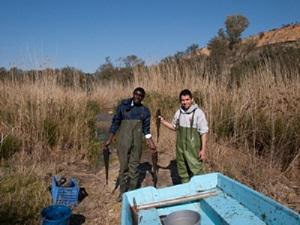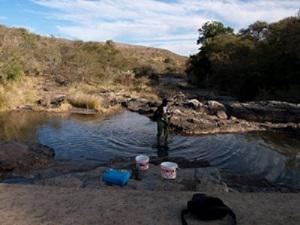Wilbert Kadye
Other projects
22 Nov 2012
Assessing the Impact of Multiple Non-Native Invasive Fishes in the Great Fish and Sundays Rivers
This study aims to assess habitats associated with indigenous fishes and document distribution patterns of invasive sharptooth catfish in the Great Fish and the Sundays River systems.

Sacrificed catfish collected from the Sundays River, South Africa.
Sharptooth catfish, Clarias gariepinus, was translocated from the Orange River into the Great Fish River, Eastern Cape in 1975 through the Orange-Fish interbasin water transfer scheme tunnel. Translocated sharptooth catfish has reached the Sundays River and are now established in many rivers in the Eastern Cape province. There is increasing concern about the conservation status of indigenous fishes, which include goldie barb, Barbus pallidus, and the endangered Eastern Cape redfin, Pseudobarbus afer, due to generalised feeding habits and mobility of non-native sharptooth catfish.

Electric fishing and habitat assessment for minnows in headwater streams.
Preliminary studies indicate that the catfish is increasing its range into mountain streams and tributaries that are the only remaining sanctuaries for indigenous fishes. Most indignoues fishes have disappeared from mainstream habitats where non-native catfish are abundant. Since the Eastern Cape’s rivers, the Great Fish and Sundays in particular, are characterised by low richness in indigenous fishes, which are mostly endemic, conservation of these fishes requires a clear understanding of factors that determine the distribution and abundance of these species.
This study will assess patterns of habitat associations of the indigenous fishes in relation to presence and absence of invasive non-native sharptooth catfish. This will allow for identification of habitats and species that are more vulnerable to sharptooth invasion and habitats that can be refugia for the indigenous fishes. Overall, the study will contribute to the mapping of distribution patterns of both indigenous and non-native fishes. This will contribute in identifying sanctuaries for protecting threatened indigenous fishes and explore for conservation options and possible control of the invasive sharptooth catfish.
Bimonthly sampling will be conducted on the longitudinal profile of the mainstream and tributaries of the Great Fish and Sundays River. At each site, major habitat types such as riffles, pools and runs will be identified and sampled. Fish will be captured using appropriate sampling gear, such as seine, gill, fyke nets, long lines and electric fishing. Physical habitat variables such as depth, substrate type an flow, will be determined at each site. Physico-chemical variables, such as temperature, conductivity, turbidity, dissolved oxygen and pH will also be measured at each site. Regression models will be used to explore the relationship between fish and habitat variables in habitats with and without the invasive sharptooth catfish. Five juvenile and five adult catfish will tagged and radio tracked daily for a period of one month in two seasons for each river. Home range analyses will be estimated using non-parametric kernel methods. Catfish diets will be examined to determine what they feed on.